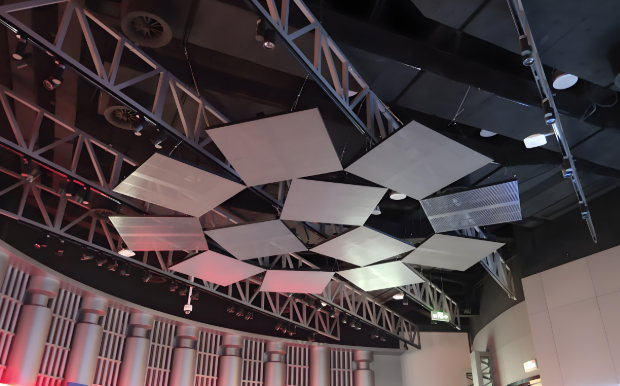In the wave of digital transformation of museums, traditional positioning technology is difficult to meet the needs of tourists for immersive guided tours and refined management due to problems such as insufficient accuracy and poor interactivity. Bluetooth AOA (angle of arrival) technology has become a key technology to solve the problem of museum positioning with its centimeter-level positioning capability, low power consumption characteristics and seamless compatibility with smart terminals. From exhibit tracking to visitor guided tours, from security management to data-based operations, AOA technology is reshaping the intelligent experience of museums and promoting the innovation of cultural communication methods.

Technical breakthrough: the principle and core advantages of centimeter-level positioning
Bluetooth AOA technology uses the phase difference of multi-antenna received signals to calculate the angle of arrival through the positioning base station array deployed in the museum, and combines the triangulation positioning algorithm to achieve precise positioning. Its core advantages include:
High-precision positioning: The coverage radius of a single base station is 15-20 meters, and the positioning accuracy is 0.1-0.5 meters, which is more than 10 times higher than the traditional Bluetooth RSSI technology (3-5 meters error). For example, in a bronze exhibition area, when a visitor approaches the display cabinet, the system can accurately identify his position and trigger an AR animation to display the casting process.
Low power consumption and compatibility: Relying on the Bluetooth 5.1 protocol, it supports native compatibility with mobile phones and other terminal devices without additional hardware, and the button battery-powered tag can last up to 10 years.
Flexible deployment and cost optimization: A single base station supports PoE power supply and is deployed on the ceiling or wall. The entire museum can be covered within 2 weeks, and the transformation cost is 40% lower than that of UWB technology.
Scenario innovation: full-link upgrade from tour guide to management
The application of Bluetooth AOA technology in museums has penetrated into the three major areas of tour guide services, security management, and operation optimization, forming a closed-loop solution:
Immersive AR tour guide: senseless interaction and personalized experience
Visitors can automatically trigger AR animations, 3D cultural relics restoration, voice explanations and other content when they approach exhibits through mobile phone APP or rented terminal devices. For example, Suzhou Museum uses "Bluetooth + sound wave + AOA" three-way positioning technology to push the explanation content of the area within a range of 0.5 meters, realizing a seamless experience of "wherever you go, where you talk". Based on real-time location and tourist interest tags (such as history, art, and technology), AI algorithms dynamically plan the optimal path to avoid crowded areas and improve visit efficiency.
Exhibit safety management: real-time tracking and abnormal alarm
Location tags are embedded in precious exhibits. Once abnormal movement occurs (such as exceeding the safe distance), the system will immediately alarm. For example, a national museum has deployed a Bluetooth AOA positioning system to achieve three functions: exhibit tracking, visitor navigation, and safety management. The risk of exhibit theft is reduced by 90%. At the same time, it monitors the flow of people in each area in real time, warns of congestion risks, and assists staff in diversion.
Data-based operations: heat map analysis and resource optimization
Statistics on the length of time tourists stay, ranking of hot exhibits, and other data to optimize exhibition design and publicity strategies. For example, museums can use Bluetooth AOA technology to analyze the length of time tourists stay in each exhibition area, understand which exhibits are more popular with tourists, and adjust the layout and display of exhibits to improve the attractiveness and educational effect of the exhibition.
Future Outlook: Virtual-Real Fusion and Ecological Expansion
Bluetooth AOA technology will further integrate indoor GIS maps, digital twins, and metaverse interactions to create a virtual-real museum space:
Cross-system linkage: seamlessly connect with the museum's existing ticketing, security, and guide apps, and provide management functions such as heat maps, trajectory playback, and electronic fences.
IoT device expansion: support linkage with smart lighting, temperature and humidity sensors, and achieve automatic environmental adjustment and exhibit protection.
Metaverse entrance: Through Bluetooth AOA positioning, visitors can "touch" historical relics in the virtual exhibition hall to achieve a seamless online and offline experience. For example, in the future, visitors can scan the exhibit label with their mobile phones, enter the virtual exhibition hall, interact with the cultural relics, and gain an in-depth understanding of their historical background and cultural value.
Bluetooth AOA technology provides core support for the intelligent transformation of museums with centimeter-level positioning accuracy, low power consumption, and high compatibility. From immersive AR guides to exhibit safety management, from data-based operations to virtual-real integration experience, AOA technology not only solves the pain points of traditional positioning technology, but also reshapes the way of cultural communication through data-driven operations and immersive experiences. At the intersection of technology and humanities, smart museums are launching a silent revolution, allowing the stories behind every cultural relic to be accurately conveyed and deeply perceived.